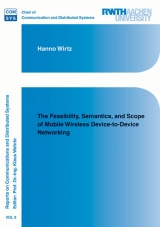The Feasibility, Semantics, and Scope of Mobile Wireless Device-to-Device Networking
Seiten
- Keine Verlagsinformationen verfügbar
- Artikel merken
Wireless networking technology in the IEEE 802.11 standard successfully complements wired network access and current mobile devices manifest wireless communication within everyday scenarios and diverse device-to-device (D2D) communication contexts. In this, D2D communication is set to enable Mobile Ad-Hoc, Delay Tolerant, and Opportunistic Networking as well as Ubiquitous Communication within the temporal and spatial scope of mobile communication contexts. While the 802.11 wireless networking capabilities of current mobile devices enable users to instantiate the necessary local, autonomous communication structures, very few academic approaches achieve the transition to real-world implementations and applications.
This thesis addresses the shortcomings of the available wireless networking technologies in supporting real-world D2D networking and proposes mechanisms that provide a suitable technical basis. First, we establish D2D networking in a network design that builds on the ubiquitously supported 802.11 Infrastructure Mode, mitigating the lack of support for the Ad-hoc Mode and exposing the performance gains of the Infrastructure Mode to mobile wireless networking. Second, we propose a design to build wireless D2D networking around the availability of desired applications and content, mitigating the inability to express interests and semantics in 802.11. Third, we realize unrestricted ubiquitous wireless networking with all encountered devices in a network-less communication mechanism that exposes the temporal and spatial dynamics, diversity, and scope of wireless contexts to mobile applications.
This thesis addresses the shortcomings of the available wireless networking technologies in supporting real-world D2D networking and proposes mechanisms that provide a suitable technical basis. First, we establish D2D networking in a network design that builds on the ubiquitously supported 802.11 Infrastructure Mode, mitigating the lack of support for the Ad-hoc Mode and exposing the performance gains of the Infrastructure Mode to mobile wireless networking. Second, we propose a design to build wireless D2D networking around the availability of desired applications and content, mitigating the inability to express interests and semantics in 802.11. Third, we realize unrestricted ubiquitous wireless networking with all encountered devices in a network-less communication mechanism that exposes the temporal and spatial dynamics, diversity, and scope of wireless contexts to mobile applications.
| Erscheint lt. Verlag | 29.1.2015 |
|---|---|
| Reihe/Serie | Reports on Communications and Distributed Systems ; 9 |
| Sprache | englisch |
| Maße | 148 x 210 mm |
| Gewicht | 309 g |
| Einbandart | Paperback |
| Themenwelt | Mathematik / Informatik ► Informatik ► Netzwerke |
| Informatik ► Software Entwicklung ► Mobile- / App-Entwicklung | |
| Schlagworte | Mobile communication • mobile wireless device-to-device networking • Wireless Networking |
| ISBN-10 | 3-8440-3367-X / 384403367X |
| ISBN-13 | 978-3-8440-3367-0 / 9783844033670 |
| Zustand | Neuware |
| Haben Sie eine Frage zum Produkt? |
Mehr entdecken
aus dem Bereich
aus dem Bereich
Das große Handbuch zum JavaScript-Framework
Buch | Hardcover (2022)
Rheinwerk (Verlag)
39,90 €
Eine umfassende Einführung
Buch | Softcover (2021)
De Gruyter Oldenbourg (Verlag)
44,95 €




